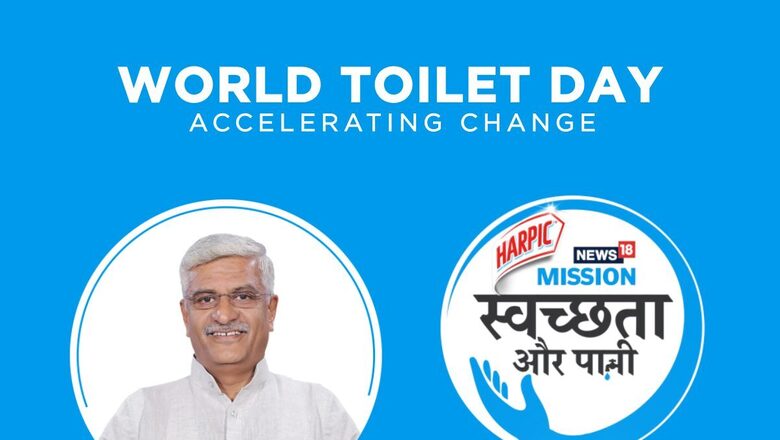
views
To understand the role of sanitation on our behavior and lives, it is pertinent to know about the broken window theory. As proven through various experiments, it can be said that visible signs of crime, anti-social behavior and unsanitary environment create a scenario that encourages further crime and disorder, including serious crimes. Any place that looks unhygienic attracts the worst of characters that further lead to unsavory acts being committed in the vicinity. Thus, Sanitation and our behavior due to it are deeply interlinked with each other. Behavior Change is the holy grail of every policy, and once the behavior change is achieved, the sustenance of the expected behavior is another challenge to surmount. World Toilet Day, observed annually on November 19 is a poignant reminder of the transformative power of behavior change. The Bharat story, it’s tryst with building a movement around sanitation through Swachh Bharat Abhiyan stems out as a tale of triumph in the war field of mind and habits. To make changes in sanitation habits of a few is an uphill task, but to alter the behavior of billions and to sustain the behavior is a story worth telling, a story worthy of emulation, I am reminded of the hummingbird’s parable, where each small effort contributes to a significant transformation.
The Swachh Bharat Abhiyan, initiated by our Honorable Prime Minister in 2014, was a clarion call towards a cleaner India by 2019. The Swachh Bharat Abhiyan made 6,03,175 villages ODF free by the construction of over 10 Crore toilets. It saved over 3,00,000 diarrhea deaths and reduced ground water contamination by over 7-12 times in ODF free villages. While, the sanitation coverage rose from 38.7 % at the time of the Swachh Bharat’s inception to 100% by the end of the Government’s first term, the larger question of a holistic sanitation coverage remained unanswered. In keeping with this goal, on the Independence Day, 2019, the Prime Minister announced the Swachh Bharat Mission 2.0 with a total out lay of 1,40,881 Crore with focus on sustainability of ODF status and solid and liquid waste management. It has added an impetus on plastic waste management as well. While 8.3 billion Tons plastic has been produced globally since 1950, nearly 60%, i.e. 6.3 Billion tons has been accumulating in landfills around the world. India’s per capita consumption is set to increase; thus, the plastic problem of the nation should be contained before it becomes an un-reversible menace. Similarly, another major challenge that India is facing today is fecal sludge management. For all toilets built in urban areas before the advent of Swachh Bharat Abhiyan, nearly 1,20,000 tons of fecal sludge are left untreated as two-thirds of all toilets were not connected to the main sewer lines. Thus, the historical baggage of fecal sludge mismanagement looked us in the eye as we embarked on the transformative journey of SBM 2.0. Similarly, Grey Water accounts for nearly 60% of all the water used in households. It has its own share of challenges, if stored for more than 24 Hours, it starts emitting foul smell and if it enters the ground, contaminates the ground water. The challenge lies in the fact that if through Jal Jeevan Mission, the Government is going to provide water through tap to 14 Crore, the volume of grey water will be staggering and the management of the same will be a huge challenge.
In a crowning report on SBM by Gates Foundation, it was found that Swachh Bharat Abhiyan saved 50,000 Rs per household per year in terms of health and man days. Thus, focus on sanitation led to an upward spike in the economic condition of the poorest of the poor. Similarly, Jal Jeevan Mission is on track to save 1.36 lives of kids in India. The feather of the cap of SBM are many, but the center piece of the cap, the shining emerald is to see the impact that SBM has on the lives of women. Having forsaken long treks in the wee hours of the morning for their daily ablutions, braving, snakes, insects and lecherous men, Women have found safety, security and honor in their toilets.
While it is important to effectuate change through policies, it is pertinent to map the progress and chronicle their impact. In this regard Swachh Bharat Sarvekshan plays an important part. In SSG 2022, nearly 5.13 crore citizens participated of which 84% felt that they have felt marked improvement in the sanitation sector since SBM-1, while 68% commented feeling satisfied with the current Sanitation projects (SBM-2) being initiated by the Government. Such high levels of satisfaction as reported by the survey is truly a vindication of our efforts, an honest reminder of our PM’s vision of 5 S for sanitation, i.e., scale, size, speed, sustainability and scalability. It would come as a pleasant surprise that out of the total villages in India, i.e., 6.4 Lakhs, nearly 4.86 Lakh villages have become ODF + villages. This is a true testament to our efforts at ensuing large scale change in the country.
India’s remarkable sanitation journey reinforces the notion that incremental actions can lead to monumental changes. It is the synergy of government, private sector, and civil society that propels this transformation, highlighting the fundamental right to hygiene and sanitation.
Gajendra Singh Shekhawat is Union Minister of Jal Shakti. Views expressed in the above piece are personal and solely that of the author. They do not necessarily reflect News18’s views.



















Comments
0 comment